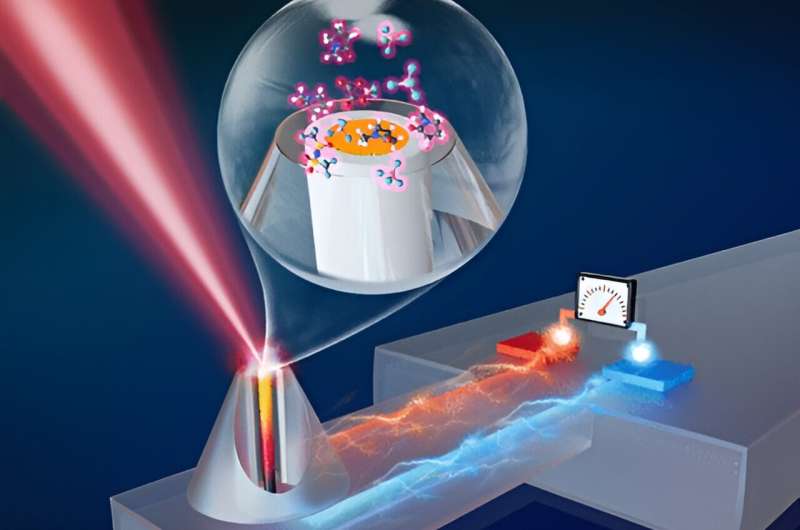This article has been reviewed according to Science X's editorial process and policies. Editors have highlighted the following attributes while ensuring the content's credibility:
fact-checked
trusted source
proofread
Scientists discover super sensor for the smallest scales

A team that included researchers at the Department of Energy's Oak Ridge National Laboratory used a new twist on an old method to detect materials at some of the smallest amounts yet recorded.
The results could lead to enhancements in security technology and aid the development of quantum sensors.
The study, published in Nano Letters, employed the Seebeck effect, a thermoelectric phenomenon discovered two centuries ago, to identify the heat and light signatures of molecules measured by the attogram—a quintillionth of a gram, or 1018 times lighter than a dollar bill. The heaviest amount weighed around 52 attograms, and the lightest around 40 attograms.
"It's essentially the first time that someone has reported a detection of the spectroscopic signal at those levels for that little material under ordinary conditions," said Ali Passian, an ORNL research scientist and co-author of the study.
"The technique itself is not new. But exploring the physics of sensing and asking the right question are the key. This discovery could pave the way for widespread deployment of cheap, reliable and accurate sensors for a wide variety of uses."
Passian collaborated on the study with fellow scientists Yaoli Zhao, Patatri Chakraborty and Thomas Thundat, all of the University of Buffalo.
The Seebeck effect, named for German physicist Thomas Seebeck, describes the voltage that results from a temperature difference in a circuit made up of two dissimilar electrical conductors, such as two wires made of different metals, when exposed to heat.
The research team relied on a silicone microcantilever probe, similar to a microscopic version of the needle on an old-fashioned record player, that harnessed the Seebeck effect by creating such a circuit and using infrared light from a laser to stimulate the molecules of the materials under study and create heat.
By bringing the probe in contact with minuscule amounts of the material, the team worked backward from the spectroscopic signals and changes in temperature difference to accurately identify and calculate the amounts of the material present: trinitrotoluene, better known as the explosive TNT, and dimethyl methylphosphonate, a compound used in flame retardants and chemical weapons.
"It's a very simple system that works surprisingly well," Passian said. "The probe has a sharp tip that we bring close to the surface and then shine the infrared light on it. We generated just a tiny amount of heat, and this probe was able to read it. We were pretty excited to discover we could detect so little material so reliably in such a noninvasive way."
The probe has been used for imaging at the nanoscale level—about nine orders of magnitude larger than an attogram—but Passian and the team were the first to use the approach for spectroscopy at such a small scale.
"Think of a small coin," Passian said. "Now shrink that coin by a million times or so. That's comparable to the size of the probe. We used the probe in a new way—to measure heat and light rather than capture an image—and it proved to be even more useful than we expected. I'm sure we can push the detection limits even further."
The probe's sensitivity and relatively low cost—thousands could be manufactured for a few hundred dollars—open up possibilities for a wide range of applications.
"Everybody wants sensors that are cheap, small, fast and easy—but also highly accurate," Passian said. "This system fits all those criteria. Because it's so small, it doesn't require a lot of bulky machinery, and we could fit hundreds or thousands of these probes on a single surface. That makes the system ideal for compact spaces, such as security checkpoints at airports or underground applications such as mining."
The team plans to test the probe to detect even smaller amounts. Results could support the building of quantum sensors, which would use the laws of quantum physics for sensing at the level of individual atoms.
"At some point, the amount of material will be too small even for this sensor," Passian said. "Then the next step will be quantum measurements. We hope this technique can help lead us there."
More information: Yaoli Zhao et al, Ultrasensitive Photothermal Spectroscopy: Harnessing the Seebeck Effect for Attogram-Level Detection, Nano Letters (2023). DOI: 10.1021/acs.nanolett.3c01710
Provided by Oak Ridge National Laboratory





















